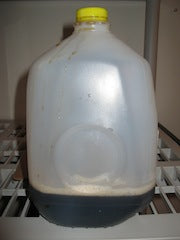October 23, 2018
Eisbock Recipe
I wanted to post a blog about a process that I often try to do with my homebrews. The process of eis'ing or freezing beer to separate water (in the form of ice) from the beer, thus making it slightly more concentrated in not only alcohol, but in flavor.
I tried this the first time with a Peppercorn Rye Bock and liked the results so much that I try to eis at least two 16-ounce flip-tops per batch unless I know it won't taste any good eis'ed (more on that later) or if it was too small of a batch to waste half-gallon on the eis versions.
Before I get into more observation-based details, let me lay out the process. I must preface this by saying that this is my extremely stripped-down way of doing eis beers. There are more legit, structured ways to do it, I'm sure, but I'm just not a very legit or structured kind of guy.
The Process
Before we begin.... you'll need these things.
- beer, already primed with sugar solution
- clean, sanitized plastic milk jug
- three sanitized 16 oz. flip-top bottles
- sanitized small funnel

Nipsey Russell (no relation)
The beer I'm showing you here is one inspired by a recipe from Charlie Papazian's book Microbrewed Adventures. The base beer is a clone recipe for Brooklyn Brewing's Chocolate Stout. I made this last year and it was a great beer and eis'ed very well. For this second attempt at the beer, I changed things up a little. I added cocoa nibs to secondary fermentation for more chocolate character. Thus, I call the beer Nibsey Russell Chocolate Stout.
So... I did this eis like I do most of my eis beers. I make a priming sugar solution proper to the entire five-gallon batch of beer. In this case, I had five gallons of beer at 53F that I wanted to be carbonated to about 2.75 so there is about 4 oz of corn sugar dissolved into 2 cups of water. I add this cooled solution to the bottling bucker per usual. I bottled my 12 oz bottles until I had about a half-gallon of primed beer left. This last half-gallon I put into a cleaned and sanitized empty milk jug.
I take that jug with about half-gallon beer and put it in the freezer.
I have no official way of knowing when it's ready. I try to get a few steps beyond slush. This example was in the freezer for about 12 hours... long enough that it was not brick-hard, but wasn't slushy either. When tipped on its side, you should see liquid moving around in there.
Take your sanitized funnel and put it in the first sanitized bottle. Pour beer into the bottle until appropriately filled and top it. Label this bottle so you remember which bottle had the first (strongest) runnings.
Repeat the process with the other two bottles, labeling them as well. You see here I didn't take my own advice and forgot to label them. So these say 1 or 2. Ha! Told you I'm not very legit or structured.
After filling the three bottles, I stop the process. I could let more ice melt and fill extra bottles, but it would defeat the purpose of extracting a more concentrated beer.
For the sake of this post, however, I did allow the ice to thaw back into beer-water so you could see how much was left over at the end.
I allow these bottles to rest just as I would normally-bottled beers to bottle condition. They do seem to take a while longer to carbonate, but I have yet to have one not carbonate eventually.
Random Thoughts on Eis'ing
Beers with strong malt character and/or spices seem to eis well. Hoppy beers DO NOT eis well. They become overly bitter and astringent. I have had great success on a few of my eis beers including:
- The aforementioned Peppercorn Rye Bock recipe in Sam Caligione's book, Extreme Brewing
- My first attempt at this chocolate stout
- Spiced pumpkin ale
- Lavender Wit - also inspired by the Belgian Wit from Extreme Brewing with added lavender and rose hips
As I mentioned, there is probably a prettier and more proper way to do this, but I like my way just fine. It may be better to do this freezing/extracting process first, then add priming sugar solution. But this pre-primed method has always worked out fine for me.
I'm sure there's a formula or equation that uses the final gravity of normal beer, the amount of beer before eis'ing, and the amount of beer after eis'ing to determine exactly how much higher one has made their beer by doing this eis process. I don't know it.
If you do, hook me up at brewmaster@northernbrewer.com. I'll follow this up with tasting notes of Nibsey Russell Chocolate Stout and its eis'ed cousin. Cheers!
Charlie P. the Beagle mix helping the author determine how much corn sugar should go into Nibsey Rusell Chocolate Stout








